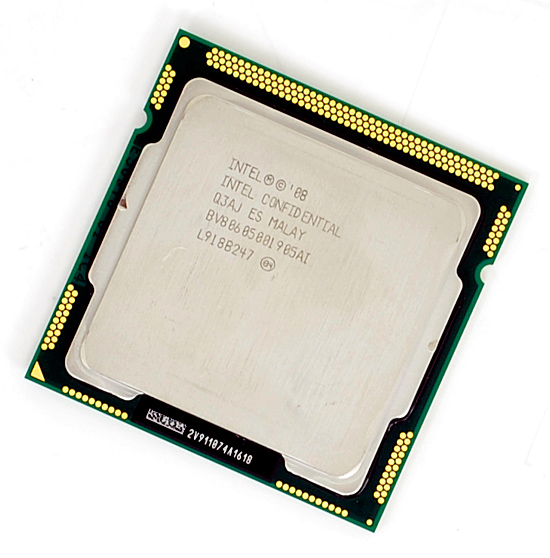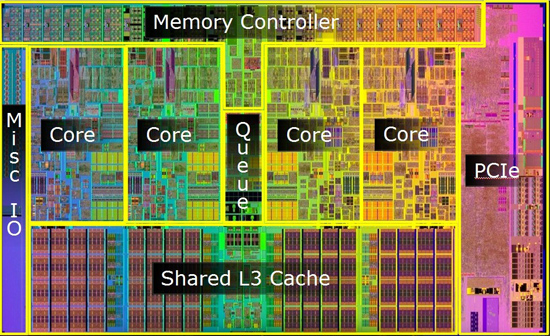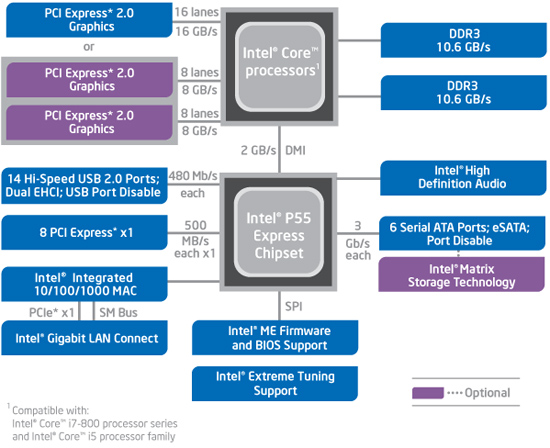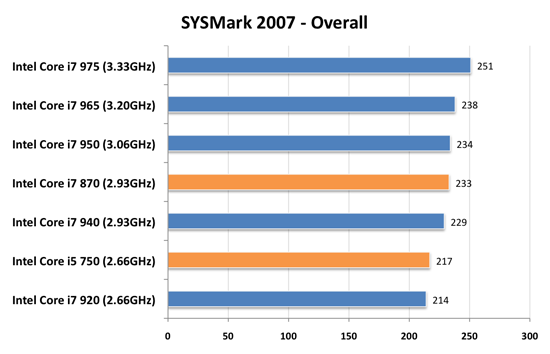Intel's Core i7 870 & i5 750, Lynnfield: Harder, Better, Faster Stronger
by Anand Lal Shimpi on September 8, 2009 12:00 AM EST- Posted in
- CPUs
Intel is on the verge of transitioning to 32nm. We'll see the first parts this year. What do you do with your 45nm fabs when you start moving volume away from them? Make really cheap quad-core Nehalems of course:

I'm talking $196. I'm talking faster than AMD's entire lineup. I'm talking about arguably the best processor of 2009. I'm talking about Lynnfield, and here's its backside:

Mmm
I spent much of the past year harping on AMD selling Nehalem-sized Phenom IIs for less than Intel sold Nehalems. With Lynnfield, Intel actually made Nehalem even bigger all while driving prices down. Like I said, what do you do when you're still making boatloads of money in a recession and are about to start emptying your 45nm fabs?
I should clear things up before we progress much further. Lynnfield is the codename for mainstream 45nm quad-core Nehalem, while Bloomfield refers to the first Nehalem launched at the end of 2008:
| Processor | Manufacturing Process | Die Size | Transistor Count | Socket |
| Bloomfield | 45nm | 263 mm2 | 731M | LGA-1366 |
| Lynnfield | 45nm | 296 mm2 | 774M | LGA-1156 |
Despite being cheaper, Lynnfield is larger than Bloomfield. The larger die is due to one major addition: an on-die PCIe controller.

Bloomfield, The First Nehalem, circa 2008

Lynnfield, Nehalem for All, circa 2009
The pink block to the right of the die is the PCIe controller, that's 16 PCIe 2.0 lanes coming right off the chip. Say hello to ultra low latency GPU communication. You'd think that Intel was about to enter the graphics market or something with a design like this.
Sacrifices were made to reduce CPU, socket and board complexity. Gone are the two QPI links that each provided 25.6GB/s of bandwidth to other CPUs or chips on the motherboard. We also lose one of the three 64-bit DDR3 memory channels, Lynnfield only has two like a normal processor (silly overachieving Bloomfield).

Intel's Bloomfield Platform (X58 + LGA-1366)
The sum is that Lynnfield is exclusively single-socket; there will be no LGA-1156 Skulltrail. While the dual-channel memory controller isn't really a limitation for quad-core parts, six and eight core designs may be better suited for LGA-1366.

Intel's Lynnfield Platform (P55 + LGA-1156)
The loss of QPI means that Lynnfield doesn't have a super fast connection to the rest of the system, but with an on-die PCIe controller it doesn't matter: the GPU is fed right off the CPU.
The Lineup
We get three Lynnfield CPUs today: the Core i7 870, Core i7 860 and the Core i5 750. Intel's branding folks told us that the naming would make sense one we saw the rest of the "Core" parts introduced; yeah that was pretty much a lie. At least there aren't any overlapping part numbers (e.g. Core i5 860 and Core i7 860).
The i7 in this case denotes four cores + Hyper Threading, the i5 means four cores but no Hyper Threading. The rules get more complicated as you bring notebooks into the fray but let's momentarily bask in marginal simplicity.
| Processor | Clock Speed | Cores / Threads | Maximum Single Core Turbo Frequency | TDP | Price |
| Intel Core i7-975 Extreme | 3.33GHz | 4 / 8 | 3.60GHz | 130W | $999 |
| Intel Core i7 965 Extreme | 3.20GHz | 4 / 8 | 3.46GHz | 130W | $999 |
| Intel Core i7 940 | 2.93GHz | 4 / 8 | 3.20GHz | 130W | $562 |
| Intel Core i7 920 | 2.66GHz | 4 / 8 | 2.93GHz | 130W | $284 |
| Intel Core i7 870 | 2.93GHz | 4 / 8 | 3.60GHz | 95W | $562 |
| Intel Core i7 860 | 2.80GHz | 4 / 8 | 3.46GHz | 95W | $284 |
| Intel Core i5 750 | 2.66GHz | 4 / 4 | 3.20GHz | 95W | $196 |
Keeping Hyper Threading off of the Core i5 is purely done to limit performance. There aren't any yield reasons why HT couldn't be enabled.
Intel was very careful with both pricing and performance of its Lynnfield processors. I'm going to go ahead and say it right now, there's no need for any LGA-1366 processors slower than a Core i7 965:

This is only one benchmark, but it's representative of what you're about to see. The Core i7 870 (LGA-1156) is as fast, if not faster, than every single LGA-1366 processor except for the ones that cost $999. Its pricing is competitive as well:

For $196 you're getting a processor that's faster than the Core i7 920. I'm not taking into account motherboard prices either, which are anywhere from $50 - $100 cheaper for LGA-1156 boards. I don't believe LGA-1366 is dead, but there's absolutely no reason to buy anything slower than a 965 if you're going that route.










343 Comments
View All Comments
ash9 - Tuesday, September 8, 2009 - link
As per Anand's article, "How Much Does it Cost to Build a P55 Motherboard?" Intel is getting around $50 min everytime a P55 board is sold with its new chips...nice, most folk wont link board prices to Intel..way to go Intel; so how much is Intel really making on its $196 i5??JonnyDough - Tuesday, September 8, 2009 - link
I love you.Avalon - Tuesday, September 8, 2009 - link
Hey Anand, how did you test stability on your max i5 750 overclock with turbo mode enabled? You said your max overclock on your i5 75 with turbo was 3.2Ghz. Do you just simply run Prime or some similar burn in that runs on all 4 cores (which would have turbo'd you to 3.96Ghz), or did you actually check a single threaded run on a single/two core(s) at 100% while getting it to run at turbo speed of 4.16Ghz(4Ghz for 2) at the same time? Thanks!Gary Key - Tuesday, September 8, 2009 - link
Stability testing is accomplished by running large renders in Lightwave 3D 9.6 x64 and Cinema4D R11 x64 at the same time while playing FarCry 2 in a window, along with Espresso, Mainconcept Reference, Lightroom, several IE windows, and Maya opened in the background. Also, it was not shown but all of the overclock results were with an 8GB memory load at DDR3-1800 or above. We try to test them like you use them. ;)Anand Lal Shimpi - Tuesday, September 8, 2009 - link
When turbo mode was enabled we made sure the system was stable with 1, 2 and 4 cores active. It had to pass all tests to be considered stable.Take care,
Anand
chizow - Tuesday, September 8, 2009 - link
Comments like this make me think you're losing touch Anand.[quote] I'm going to go ahead and say it right now, there's no need for any LGA-1366 processors slower than a Core i7 965[/quote]
[quote]For $196 you're getting a processor that's faster than the Core i7 920. I'm not taking into account motherboard prices either, which are anywhere from $50 - $100 cheaper for LGA-1156 boards. I don't believe LGA-1366 is dead, but there's absolutely no reason to buy anything slower than a 965 if you're going that route.[/quote]
There's about 800 reasons I can think of for other LGA1366 chips besides the Core i7 965, and there was a time you tipped your hat to amazing value gained from overclocking. I guess you're too enamored nowadays throwing that money away on those overpriced $1500 Intel Nehalems on boring Mac platforms that aren't conducive to user modifications to begin with.
jordanclock - Tuesday, September 8, 2009 - link
I fail to see how Anand is "losing his touch." He has a very valid point: Buying anything less than the highest range i7's doesn't make sense right now. Lynnfield is very competitive to the sub-965 i7's, but with a much lower price (for both the CPU and motherboard). The 965/975 have many situations where they out-perform the i5's by a great deal, but unless you're buying a CPU for extreme performance, the i5 is a much better deal no matter how you slice it.chizow - Tuesday, September 8, 2009 - link
It seems you missed the point, entirely. Once you factor in overclocking, there is about 800 reasons to buy a cheaper LGA1366 CPU than the i7 965 because those cheaper processors tend to reach the same maximum clockspeeds as their overpriced siblings. Even a modest 500-600MHz overclock on a "pointless" $200 i7 920 surpasses the performance level you could buy with a $1000 stock XE part from Intel. Failing to acknowledge this reality tells me both you and he are losing touch....Anand Lal Shimpi - Tuesday, September 8, 2009 - link
Forgive me as apparently I wasn't clear enough in what I was trying to say there.I would absolutely recommend the Core i7 920 over a $1000 Core i7 Extreme. In fact, I did back when the Core i7 first launched.
What I was trying to say in those sentences was Lynnfield changes all of that. Instead of buying a Core i7 920, I'd recommend a Core i5 750 (and saving money) or a Core i7 860 (and saving a bit less money). Those are both LGA-1156 processors.
The only reason anyone would want LGA-1366 is if they want to build something faster than a Core i7 870, which only leaves the Core i7 965/975.
My recommendation *isn't* to buy a $1000 CPU, it's to buy something much cheaper. Because of this, most of the LGA-1366 lineup is made obsolete by Lynnfield.
Does that make more sense?
Take care,
Anand
chizow - Tuesday, September 8, 2009 - link
I see your point and thought it might be what you were hinting at, but the message did come off awfully distorted with the way it was worded. If there was a 3.2-3.3GHz Lynnfield I suppose that would have made the 965 XE obsolete as well? The reality of it is, if there weren't other options besides $1000+ XE CPUs, X58 would be a dead platform akin to other failed Intel efforts of the past like Skulltrail.But that's not the case. X58 still has a place even though performance overlaps with Lynnfield on the low-end. In multi-GPU and gaming situations there's still clearly a place for X58/LGA1366 as Page 9 indicates. In situations where the end-user intends to overclock, any of the artificial gains from Lynnfield's Turbo modes are going to be negated.
Personally, from a consumer standpoint, I feel Intel botched the whole X58/P55 design and launch starting with the decision to go with 2 sockets. Not only did the feature that provided the least benefit (triple vs. dual channel) drive the reason for the socket/pin count difference, they gimp the platform with superior tech by cutting PCIE lanes in half.
I would've much rather have seen a 32-lane integrated PCIE controller on X58 and have a unified LGA1188 socket instead of 2 sockets, both of which have blemishes and signficant downsides as we have now.